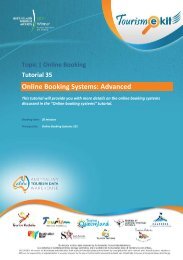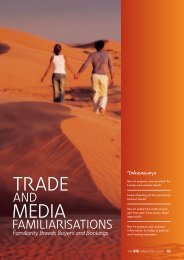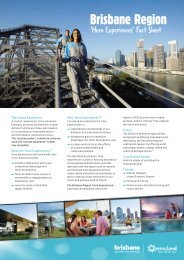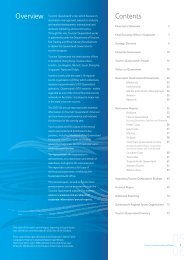Outback Education Handbook PDF - Tourism Queensland
Outback Education Handbook PDF - Tourism Queensland
Outback Education Handbook PDF - Tourism Queensland
Create successful ePaper yourself
Turn your PDF publications into a flip-book with our unique Google optimized e-Paper software.
27<br />
Thargomindah<br />
Quirky fact :<br />
powers on!<br />
Energy sources used to generate electricity include water, wind, sun,<br />
gas diesel fuel, tidal energy, waves and geothermal energy.<br />
Curriculum Information<br />
Year<br />
Learning and Assessment (Place and Space)<br />
6 Natural Resources - Provision of Energy<br />
7 Sustaining the <strong>Outback</strong> - Renewable Energy Schemes<br />
Description<br />
In 1891, the Bulloo Shire Council embarked on a project of drilling an artesian bore to provide Thargomindah’s<br />
town water supply. The water pressure was so strong that by 1893 it was decided to harness it as energy to<br />
drive a generating plant for the supply of electricity to the town. This formed the Thargomindah Hydro Electric<br />
Plant, a distinction that would mark it as the first town in Australia to have a hydro electricity plant and third in<br />
the world behind Paris and London to have street lighting generated by hydro power. The plant continued to<br />
supply electricity until 1951, when the Capricornia Electricity Board installed a diesel plant, which still operates<br />
today.<br />
In the early 20th century, <strong>Queensland</strong> was characterised by isolated urban areas, separated by large distances,<br />
with the majority of townships on the coast and in the southeast. Rural properties tended to be large and<br />
pastoral service towns were small. At the turn of the century private companies supplied power to Brisbane,<br />
Charters Towers and Rockhampton. During the following 20 years other major centres developed power<br />
stations, most of which were small thermal, diesel or gas engine driven plants. Up until the 1940s electricity<br />
generation remained largely in the hands of local government and private enterprise. However, during World<br />
War II all domestic resources were diverted into essential services and the war effort, and afterwards all of the<br />
generating authorities needed to replace and expand their generating equipment.<br />
The provision of electricity to rural areas became a major focus of the Electricity Commission during the 1950s<br />
and increasingly thereafter, supplies were delivered by large power stations located close to their power<br />
sources, with huge transmission networks.<br />
Indicative of its heritage, in 2002 as part of “Year of the <strong>Outback</strong>” celebrations, Thargomindah implemented two<br />
state-of-the-art renewable energy schemes that would place the town at the forefront of Australia’s 21st century<br />
power generation.<br />
Courtesy of Bulloo Shire Council<br />
Courtesy of Bulloo Shire Council<br />
Hydro power display<br />
Thargomindah powers on!<br />
068<br />
<strong>Queensland</strong>’s <strong>Outback</strong> <strong>Education</strong> <strong>Handbook</strong> | Natural <strong>Outback</strong>

















